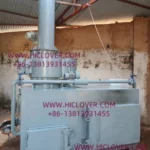Medical Waste Incineration Solutions in Cameroon: HICLOVER’s Proven Experience
Growing Demand in Cameroon’s Healthcare and Defense Sectors
Cameroon, located in Central Africa, faces increasing pressure to safely manage hazardous medical waste from hospitals, research institutions, and military health facilities. With a rising population and expanding healthcare infrastructure, the government has prioritized sustainable medical waste disposal systems that comply with international environmental and health standards.
In particular, military health services and national research programs require robust and reliable incineration systems to protect both soldiers and civilians from the risks associated with infectious medical waste.
HICLOVER’s Contribution to Cameroon
HICLOVER has a strong track record of supplying high-quality medical waste incinerators across Africa. A recent project included the delivery of a 100 kg/hour capacity medical incinerator (Model YD100, equivalent to TS100) to a major health authority within Cameroon. This unit was designed to support a government health program under the Ministry of Defense, demonstrating the trust placed in HICLOVER by official institutions.
By partnering with international health organizations and national defense health directorates, HICLOVER has proven its ability to deliver customized, high-performance incinerators that meet both local needs and international donor requirements.
Technical Advantages of the YD100/TS100 Model
The HICLOVER YD100 / TS100 incinerator is engineered for mid-scale healthcare facilities, research institutes, and defense medical units.
-
Capacity: 100 kg/hour average burn rate
-
Primary Chamber: Durable refractory lining, 1,200 liters
-
Secondary Chamber: 400 liters, ≥1100°C, ≥2 seconds retention time
-
Fuel Options: Diesel, natural gas, or LPG
-
Control Mode: PLC automation with temperature monitoring and safety interlocks
-
Emission Control Options:
-
Wet scrubber system for acid gas treatment
-
Advanced smoke abatement package with quench tower, activated carbon, and baghouse filter
-
These features ensure clean combustion, reduced emissions, and long-term durability, even under the challenging waste streams often encountered in African healthcare systems.
Why Cameroon is a Strategic Market
-
Government-backed programs: Ministries of Health and Defense are investing in modern waste treatment to protect public health and the environment.
-
International support: Projects funded by global organizations (UNDP, WHO, World Bank) often require compliant incineration technology.
-
Urban-rural balance: Large hospitals in Yaoundé and Douala need centralized units, while rural clinics and military posts benefit from containerized, mobile solutions.
In local context:
“La gestion durable des déchets médicaux est devenue une priorité au Cameroun, et les incinérateurs modernes comme HICLOVER TS100 répondent à ce besoin.”
(French: Sustainable medical waste management has become a priority in Cameroon, and modern incinerators such as the HICLOVER TS100 address this need.)
Conclusion
HICLOVER’s experience in delivering the 100 kg/hour YD100/TS100 incinerator to a key government-backed program in Cameroon highlights its ability to serve demanding clients in both the healthcare and defense sectors. With proven technology, advanced smoke emission control systems, and flexible configurations, HICLOVER continues to be a trusted partner for medical waste incineration solutions in Cameroon and across Africa.
For specifications and procurement inquiries:
www.hiclover.com
sales@hiclover.com







